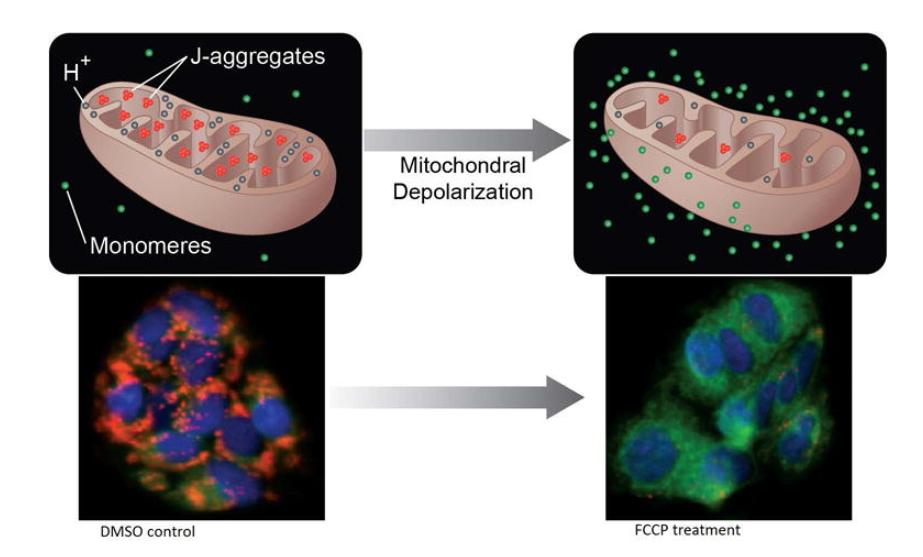Mitochondrial Membrane Potential Analysis
Online InquiryCellular energy (ATP) in eukaryotic mitochondria is produced by oxidative phosphorylation. During this electron transfer from electron donors to electron acceptors, the mitochondrial electron transport chain generates an electrochemical gradient through a series of redox reactions that drive ATP synthesis and generate the mitochondrial membrane potential. Mitochondrial function is a key indicator of cell health, and mitochondrial membrane potential is a key parameter for evaluating mitochondrial function. Creative Proteomics provides mitochondrial membrane potential assay services for mitochondrial function analysis. We can help our customers not only detect dynamic changes in relative mitochondrial membrane potential, but also perform endpoint detection of relative mitochondrial membrane potential at specific time points.
 Fig. 1
Mitochondrial membrane potential assay principle. (Sakamuru, Srilatha, Matias S. Attene-Ramos, and Menghang Xia,
2016)
Fig. 1
Mitochondrial membrane potential assay principle. (Sakamuru, Srilatha, Matias S. Attene-Ramos, and Menghang Xia,
2016)
Overview of the mitochondrial membrane potential
Mitochondrial (dys)functions have been associated with a wide range of diseases, including cancer, cardiovascular diseases, diabetes, and neurodegenerative diseases. The toxicity of exogenous compounds can reduce mitochondrial membrane potential by perturbing various macromolecules in the mitochondria, which can have direct or indirect effects on mitochondrial functions. Mitochondrial membrane potential remains relatively stable under normal physiological activity. Long-term disturbances have detrimental effects on cellular health and lead to various pathophysiologies. In addition, a decrease in the mitochondrial membrane potential may also be linked to apoptosis. The dissipation of mitochondrial membrane potential has been used as an early indicator for apoptosis.
Our mitochondrial membrane potential analysis service
Monitoring mitochondrial membrane potential provides a sensitive and early indicator of mitochondrial integrity and is essential for identifying mitochondrial dysfunction associated with pathological disease and apoptosis. Based on fluorescent detection methods and various testing platforms, including microplate reader, fluorescence microscopy, and flow cytometry, we are committed to providing reliable and effective mitochondrial membrane potential assay service.
In addition to cell membrane permeable fluorescent dyes such as tetramethylrhodamine methyl and ethyl esters (TMRM and TMRE), JC-1 can also be available to measure changes in mitochondrial membrane potential assays in our service. JC-1 is an ideal fluorescent probe widely used to detect mitochondrial membrane potential, which can be used to detect cell, tissue, or purified mitochondrial membrane potential.
- Detection of dynamic changes in relative mitochondrial membrane potential
- Endpoint detection of relative mitochondrial membrane potential at specific time points
Acceptable sample type
-Adherent cells
-Suspension cells
Advantages of our services
- Rich experience in detecting mitochondrial function analysis
- Measure changes in mitochondrial membrane potential in live cells
- Quantitative high-throughput assays for mitochondrial membrane potential and cell viability multiplex assay
- Mitochondrial toxicity screening of multiple compound libraries by assessing the effects of compounds on mitochondrial membrane potential
- Rapid turnaround and cost-effective
If you have any questions or concerns, feel free to contact us at any time. Our goal is to exceed your expectations and provide you with the best service possible.
Reference
- Sakamuru, Srilatha, Matias S. Attene-Ramos, and Menghang Xia. "Mitochondrial membrane potential assay." High-throughput screening assays in toxicology (2016): 17-22.
Related Services
* For Research Use Only. Not for use in diagnostic procedures.








